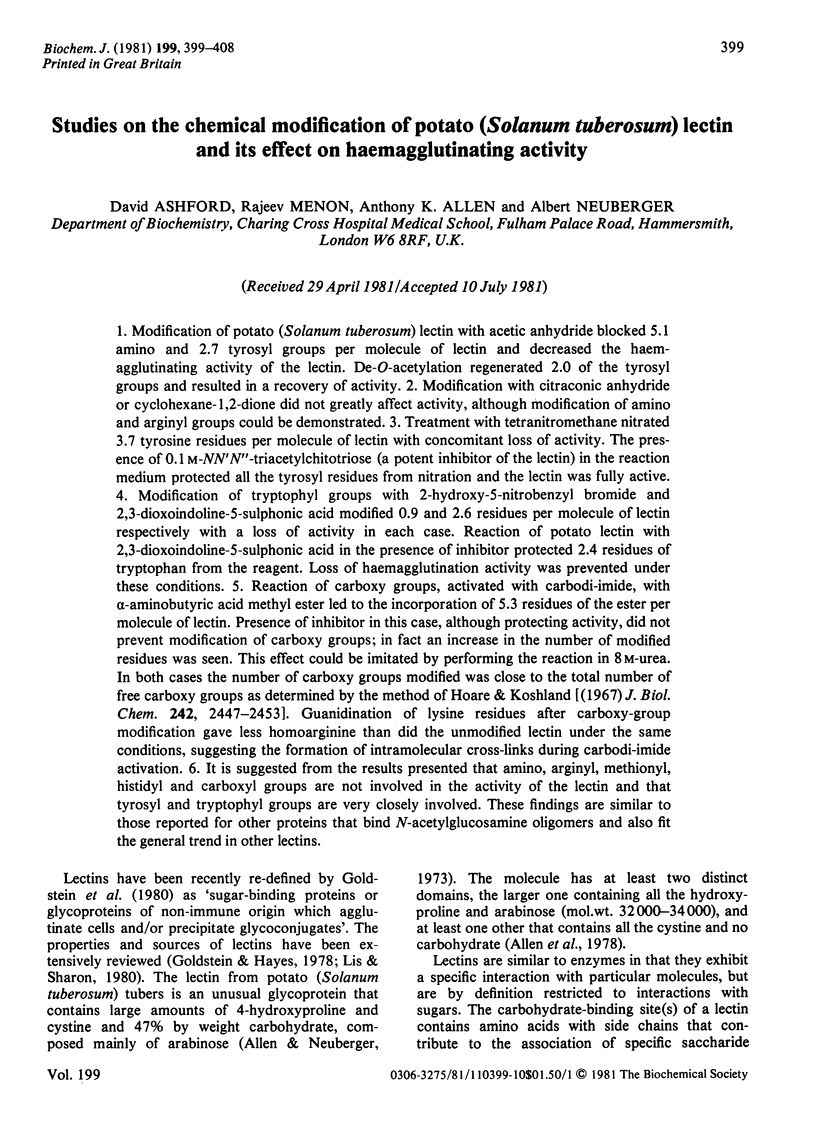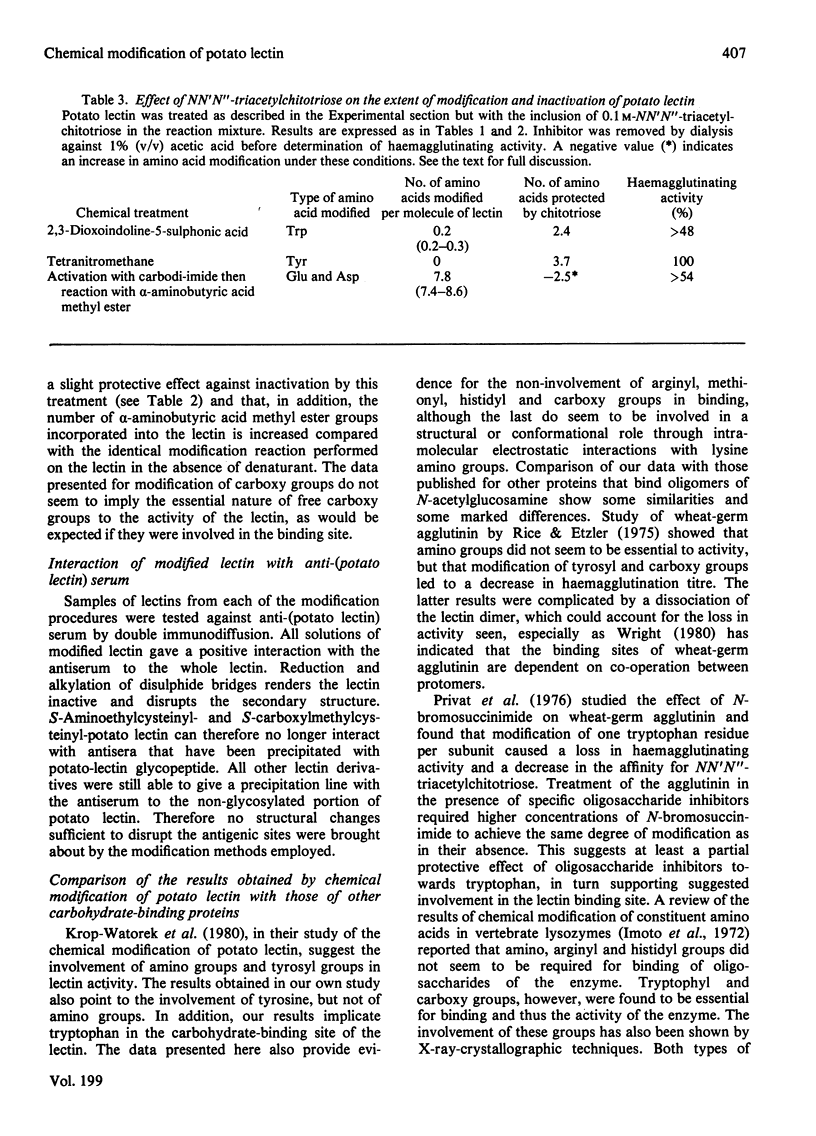Abstract
1. Modification of potato (Solanum tuberosum) lectin with acetic anhydride blocked 5.1 amino and 2.7 tyrosyl groups per molecule of lectin and decreased the haemagglutinating activity of the lectin. De-O-acetylation regenerated 2.0 of the tyrosyl groups and resulted in a recovery of activity. 2. Modification with citraconic anhydride or cyclohexane-1,2-dione did not greatly affect activity, although modification of amino and arginyl groups could be demonstrated. 3. Treatment with tetranitromethane nitrated 3.7 tyrosine residues per molecule of lectin with concomitant loss of activity. The presence of 0.1m-NN′N″-triacetylchitotriose (a potent inhibitor of the lectin) in the reaction medium protected all the tyrosyl residues from nitration and the lectin was fully active. 4. Modification of tryptophyl groups with 2-hydroxy-5-nitrobenzyl bromide and 2,3-dioxoindoline-5-sulphonic acid modified 0.9 and 2.6 residues per molecule of lectin respectively with a loss of activity in each case. Reaction of potato lectin with 2,3-dioxoindoline-5-sulphonic acid in the presence of inhibitor protected 2.4 residues of tryptophan from the reagent. Loss of haemagglutination activity was prevented under these conditions. 5. Reaction of carboxy groups, activated with carbodi-imide, with α-aminobutyric acid methyl ester led to the incorporation of 5.3 residues of the ester per molecule of lectin. Presence of inhibitor in this case, although protecting activity, did not prevent modification of carboxy groups; in fact an increase in the number of modified residues was seen. This effect could be imitated by performing the reaction in 8m-urea. In both cases the number of carboxy groups modified was close to the total number of free carboxy groups as determined by the method of Hoare & Koshland [(1967) J. Biol. Chem. 242, 2447–2453]. Guanidination of lysine residues after carboxy-group modification gave less homoarginine than did the unmodified lectin under the same conditions, suggesting the formation of intramolecular cross-links during carbodi-imide activation. 6. It is suggested from the results presented that amino, arginyl, methionyl, histidyl and carboxyl groups are not involved in the activity of the lectin and that tyrosyl and tryptophyl groups are very closely involved. These findings are similar to those reported for other proteins that bind N-acetylglucosamine oligomers and also fit the general trend in other lectins.
Full text
PDF









Selected References
These references are in PubMed. This may not be the complete list of references from this article.
- Allen A. K., Desai N. N., Neuberger A., Creeth J. M. Properties of potato lectin and the nature of its glycoprotein linkages. Biochem J. 1978 Jun 1;171(3):665–674. doi: 10.1042/bj1710665. [DOI] [PMC free article] [PubMed] [Google Scholar]
- Allen A. K., Desai N. N., Neuberger A. Purification of the glycoprotein lectin from the broad bean (Vicia faba) and a comparison of its properties with lectins of similar specificity. Biochem J. 1976 Apr 1;155(1):127–135. doi: 10.1042/bj1550127. [DOI] [PMC free article] [PubMed] [Google Scholar]
- Allen A. K., Neuberger A., Sharon N. The purification, composition and specificity of wheat-germ agglutinin. Biochem J. 1973 Jan;131(1):155–162. doi: 10.1042/bj1310155. [DOI] [PMC free article] [PubMed] [Google Scholar]
- Allen A. K., Neuberger A. The purification and properties of the lectin from potato tubers, a hydroxyproline-containing glycoprotein. Biochem J. 1973 Oct;135(2):307–314. doi: 10.1042/bj1350307. [DOI] [PMC free article] [PubMed] [Google Scholar]
- Atassi M. Z., Zablocki W. Conformation, enzymic activity, and immunochemistry of a lysozyme derivative modified at tryptophan 123 by reaction with 2,3-dioxo-5-indolinesulfonic acid. J Biol Chem. 1976 Mar 25;251(6):1653–1658. [PubMed] [Google Scholar]
- Blake C. C., Johnson L. N., Mair G. A., North A. C., Phillips D. C., Sarma V. R. Crystallographic studies of the activity of hen egg-white lysozyme. Proc R Soc Lond B Biol Sci. 1967 Apr 18;167(1009):378–388. doi: 10.1098/rspb.1967.0035. [DOI] [PubMed] [Google Scholar]
- Cermáková M., Entlicher G., Kocourek J. Studies on phytohemagglutinins. XXVII. A study of the pea lectin binding site. Biochim Biophys Acta. 1976 Feb 20;420(2):236–245. doi: 10.1016/0005-2795(76)90315-9. [DOI] [PubMed] [Google Scholar]
- Desai N. N., Allen A. K. The purification of potato lectin by affinity chromatography on an N,N',N''-triacetylchitotriose-Sepharose matrix. Anal Biochem. 1979 Feb;93(1):88–90. [PubMed] [Google Scholar]
- Dixon H. B., Perham R. N. Reversible blocking of amino groups with citraconic anhydride. Biochem J. 1968 Sep;109(2):312–314. doi: 10.1042/bj1090312. [DOI] [PMC free article] [PubMed] [Google Scholar]
- Goldstein I. J., Hayes C. E. The lectins: carbohydrate-binding proteins of plants and animals. Adv Carbohydr Chem Biochem. 1978;35:127–340. doi: 10.1016/s0065-2318(08)60220-6. [DOI] [PubMed] [Google Scholar]
- Hassing G. S., Goldstein I. J. Further chemical modification studies on concanavalin A, the carbohydrate binding protein of the jack bean. Biochim Biophys Acta. 1972 Jul 21;271(2):388–399. doi: 10.1016/0005-2795(72)90214-0. [DOI] [PubMed] [Google Scholar]
- Hassing G. S., Goldstein I. J., Marini M. The role of protein carboxyl groups in carbohydrate-concanavalin A interaction. Biochim Biophys Acta. 1971 Jul 25;243(1):90–97. doi: 10.1016/0005-2795(71)90040-7. [DOI] [PubMed] [Google Scholar]
- Hoare D. G., Koshland D. E., Jr A method for the quantitative modification and estimation of carboxylic acid groups in proteins. J Biol Chem. 1967 May 25;242(10):2447–2453. [PubMed] [Google Scholar]
- Krop-Watorek A., Morawiecka B., Izbicka E. Purification and effect of chemical modifications on potato lectin activity. Arch Immunol Ther Exp (Warsz) 1980;28(4):541–545. [PubMed] [Google Scholar]
- LIENER I. E., WADA S. Chemical modification of the soy bean hemagglutinin. J Biol Chem. 1956 Oct;222(2):695–704. [PubMed] [Google Scholar]
- Lönngren J., Goldstein I. J. Chemical modification studies on the alpha-D-galactopyranosyl binding lectin from the seeds of Bandeiraea simplicifolia. Biochim Biophys Acta. 1976 Jul 19;439(1):160–166. doi: 10.1016/0005-2795(76)90172-0. [DOI] [PubMed] [Google Scholar]
- Patthy L., Smith E. L. Reversible modification of arginine residues. Application to sequence studies by restriction of tryptic hydrolysis to lysine residues. J Biol Chem. 1975 Jan 25;250(2):557–564. [PubMed] [Google Scholar]
- Privat J. P., Lotan R., Bouchard P., Sharon N., Monsigny M. Chemical modification of the tryptophan residues of wheat-germ agglutinin. Effect on fluorescence and saccharide-binding properties. Eur J Biochem. 1976 Sep 15;68(2):563–572. doi: 10.1111/j.1432-1033.1976.tb10844.x. [DOI] [PubMed] [Google Scholar]
- RUPLEY J. A. THE HYDROLYSIS OF CHITIN BY CONCENTRATED HYDROCHLORIC ACID, AND THE PREPARATION OF LOW-MOLECULAR-WEIGHT SUBSTRATES FOR LYSOZYME. Biochim Biophys Acta. 1964 Nov 1;83:245–255. doi: 10.1016/0926-6526(64)90001-1. [DOI] [PubMed] [Google Scholar]
- Vancurová D., Tichá M., Kocourek J. Studies on phytohemagglutinins. XXVIII. Chemical modifications of the lectin from seeds of the lentil (Lens esculenta Moench.) Biochim Biophys Acta. 1976 Dec 22;453(2):301–310. doi: 10.1016/0005-2795(76)90125-2. [DOI] [PubMed] [Google Scholar]
- Ziska P., Eifler R., Franz H. Chemical modification studies on the D-galactopyranosyl binding lectin from the mistletoe Viscum album L. Acta Biol Med Ger. 1979;38(9):1361–1363. [PubMed] [Google Scholar]


